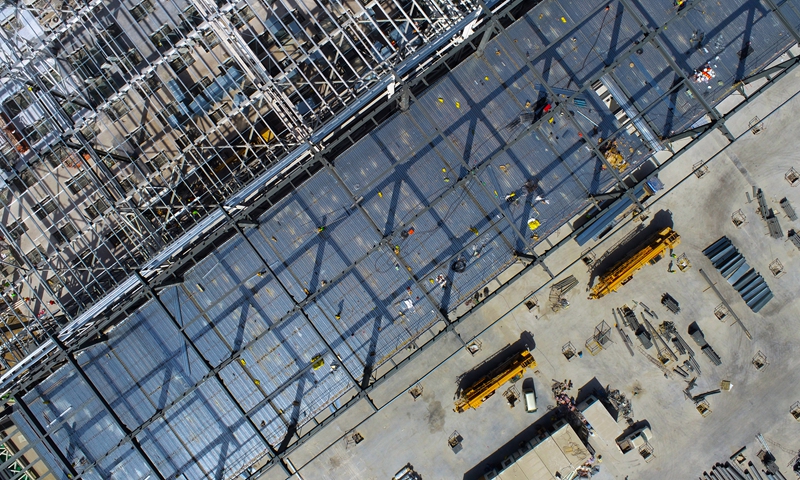
Construction is underway for a monocrystalline silicon smart factory project in Yinchuan, Northwest China’s Ningxia Hui Autonomous Region on April 5, 2022. The 50 GW solar project involves 13.98 billion yuan ($2.2 billion) in total investment. It is expected to become operational by the end of the year with the creation of more than 4,000 jobs. Photo: cnsphoto
China’s fixed-asset investment expanded 9.3 percent year-on-year from January to March, data from China’s Q1 economic figures showed on Monday.
As economic downward pressure mounts due to the resurgence of COVID-19 in multiple Chinese cities, the investment growth as one of the "three drivers" of growth will play a prominent role in stabilizing the economy, experts said.
From January to March, China's investment in fixed assets shot up 9.3 percent year-on-year to 10.48 trillion yuan ($1.64 trillion), slowing from 12.2% in the first two months. On a monthly basis, the country's fixed-asset investment climbed 0.61 percent in March from February, according to data released by the National Bureau of Statistics on Monday.
Infrastructure investment has gained 8.5 percent in the first quarter on a yearly basis, up from the 8.1 percent growth in the first two months.
Investment in manufacturing expanded by 15.6 percent in the first quarter and that high-tech industries saw one of the largest increases, picking up 27 percent from the same time last year.
Real estate development investment increased by 0.7 percent year-on-year in the first three months though the commercial floor space sold fell by 13.8 percent.
The infrastructure construction has maintained good momentum in the first quarter and is expected to become the most obvious driver to stabilize economic growth this year, Cong Yi, a professor at the Tianjin University of Finance and Economics told the Global Times.
“Many of China's infrastructure projects have kicked off and been put in force earlier this year than usual. Although the epidemic may have disrupted some project construction since March, that are less affected than it did to consumption,” Cong said.
The sufficient supply of special bonds and early start of major projects are positive factors supporting infrastructure investment this year, Cong added.
China's top economic planner announced in January that it will moderately front-load infrastructure investment and steadily push forward the 102 mega projects earmarked for the 14th Five-Year Plan period (2021-25) to achieve concrete results.
Since then, the growth rate of infrastructure has shown an upward trend.
According to statistics from Zhongtai Securities, as of Thursday, 25 provinces have disclosed their plans of investment in major local projects in 2022, with a total annual planned investment of 12.27 trillion yuan, up 14.7 percent on a yearly basis, the highest growth rate since 2019.
According to this year's government work report, the country plans to issue a total of 3.65 trillion yuan of special-purpose bonds for local governments in 2022 and those for project construction have all been issued, said the Ministry of Finance on April 12.
Global Times

